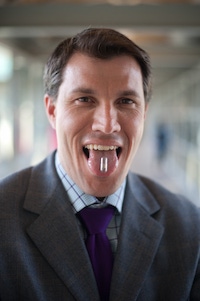August 25, 2016

Edible batteries one day could power ingestible medical devices designed to diagnose and treat health conditions, researchers told attendees and the press at the 252nd National Meeting and Exposition of the American Chemical Society (ACS; Washington, DC) in Philadelphia this week. The batteries are made with melanin pigments, which occur naturally in the body. Further research is being conducted using other biomaterials such as pectin and developing packaging materials that will safely deliver the battery to the stomach.
|
Christopher Bettinger, PhD. |
While ingestible battery-powered devices have existed for many years, they are either designed to pass through the body in a relatively short amount of time and be excreted—a camera that supports endoscopic procedures is the primary example—or, in the case of pacemakers, the devices are engineered in such a way that the toxic components of the battery have a very low chance of coming into contact with the body. For low-power, repeat applications, such as drug delivery devices, that are meant to be swallowed, non-toxic, degradable batteries would be ideal. That observation led Christopher Bettinger, PhD, to begin thinking about “biologically derived materials that could replace some of these things you might find in a Radio Shack.” He and his team at Carnegie Mellon University (CMU; Pittsburgh) turned to melanins and other naturally occurring compounds. Melanins absorb ultraviolet light to quench free radicals; they also bind and unbind metallic ions. “We thought, this is basically a battery,” says Bettinger.
The researchers experimented with using melanin pigments at the positive and negative terminals; various electrode materials such as manganese oxide and sodium titanium phosphate; and biocompatible cations (positively charged ions) such as copper and iron. The resulting battery can power a 5-mW device for up to 18 hours using 600 mg of active melanin as a cathode, according to the researchers.
The pigments are identical to what you would find in squid ink pasta, explained Bettinger at a press conference on August 23 during the ACS meeting. “If you’ve ever had squid-ink pasta, you’ve already consumed more melanin than is contained in the battery.”
Also at the press conference, post-doctoral researcher Hang-Ah Park showed a 3D-printed, degradable mock up of the ingestible battery packaged in a gel similar to what you might see in a vitamin. (The video of the press conference is embedded at the end of this article.)
Although the edible battery has low capacity, that is not an issue, says Bettinger, because “by definition, an ingestible, degradable device is in the body for no longer than 20 hours or so.” He envisions using the battery for sensing gut microbiome changes and releasing medication, as needed, and delivering bursts of vaccines over several hours before degrading.
It will be some time before we will see these batteries outside the lab, but Bettinger’s team has already found another use for them: Probing the structure and chemistry of the melanin pigments themselves to better understand how they work.
About the Author(s)
You May Also Like





